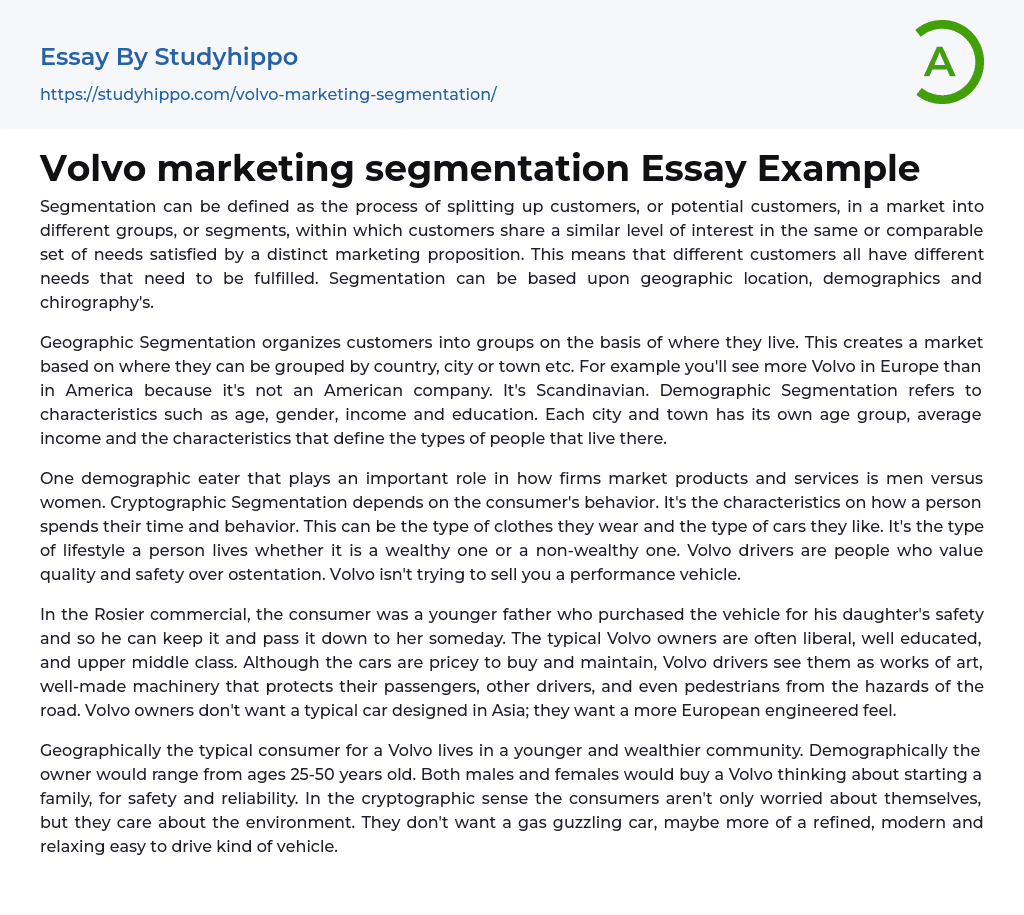Segmentation can be defined as the process of splitting up customers, or potential customers, in a market into different groups, or segments, within which customers share a similar level of interest in the same or comparable set of needs satisfied by a distinct marketing proposition. This means that different customers all have different needs that need to be fulfilled. Segmentation can be based upon geographic location, demographics and chirography's.
Geographic Segmentation organizes customers into groups on the basis of where they live. This creates a market based on where they can be grouped by country, city or town etc. For example you'll see more Volvo in Europe than in America because it's not an American company. It's Scandinavian. Demographic Segmentation refers to characteristics such as age, gender, income and education
.... Each city and town has its own age group, average income and the characteristics that define the types of people that live there.
One demographic eater that plays an important role in how firms market products and services is men versus women. Cryptographic Segmentation depends on the consumer's behavior. It's the characteristics on how a person spends their time and behavior. This can be the type of clothes they wear and the type of cars they like. It's the type of lifestyle a person lives whether it is a wealthy one or a non-wealthy one. Volvo drivers are people who value quality and safety over ostentation. Volvo isn't trying to sell you a performance vehicle.
In the Rosier commercial, the consumer was a younger father who purchased the vehicle for his daughter's safety and so he can keep it and pass it down to
her someday. The typical Volvo owners are often liberal, well educated, and upper middle class. Although the cars are pricey to buy and maintain, Volvo drivers see them as works of art, well-made machinery that protects their passengers, other drivers, and even pedestrians from the hazards of the road. Volvo owners don't want a typical car designed in Asia; they want a more European engineered feel.
Geographically the typical consumer for a Volvo lives in a younger and wealthier community. Demographically the owner would range from ages 25-50 years old. Both males and females would buy a Volvo thinking about starting a family, for safety and reliability. In the cryptographic sense the consumers aren't only worried about themselves, but they care about the environment. They don't want a gas guzzling car, maybe more of a refined, modern and relaxing easy to drive kind of vehicle.
- Chief Executive Officer essays
- Convenience Store essays
- Firm essays
- Training And Development essays
- Unilever essays
- Variable Cost essays
- Virgin Group essays
- Bargaining essays
- Entity essays
- Pest analysis essays
- Renault essays
- Truck essays
- chrysler essays
- The city essays
- Racing essays
- Advertising essays
- Audience Theory essays
- Competitor Analysis essays
- Consumer essays
- Marketing Management essays
- Marketing Mix essays
- Marketing Plan essays
- Marketing Research essays
- Marketing Strategy essays
- Point Of Sale essays
- Price essays
- Procurement essays
- Product essays
- Product Differentiation essays
- Promotion essays
- Promotion And Marketing Communications essays
- Retailing essays
- Trademark essays
- Anheuser-busch essays
- Brands essays
- Detergent essays
- Product Placement essays
- Research Design essays
- New Product Development essays
- Advertisement essays
- Brand essays
- Sales Promotion essays
- Advertising campaign essays
- Consumer behaviour essays
- Offer And Acceptance essays
- Wal-Mart essays
- Discover essays
- John Locke essays
- 9/11 essays
- A Good Teacher essays




